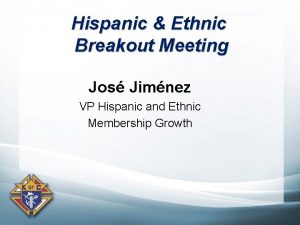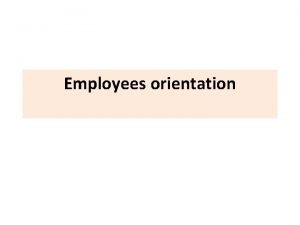Learning From Hispanic Employees Understand your employees and






























- Slides: 30

Learning From Hispanic Employees Understand your employees and improve human resource management Greg Coffta Bilingual Dairy Support Specialist Cornell University, Department of Animal Science

Background Ø Training and Facilitation in Spanish has been provided to dairy farms across New York State since July 2007 Ø To date, the program has worked with over 200 Hispanic employees on 41 farms in 17 counties Ø This program is provided through Cornell University, Department of Animal Science and made possible by funding from the New York Farm Viability Institute

A Learning Experience Deliverable training modules were created at the beginning of the project in July ’ 06 The nature of the project changed from delivering training modules to providing facilitation

Cultural Dynamics Power Distance Collectiveness Context in Communication Context of Communication


Power Distance The extent to which the less powerful members of institutions and organizations expect and accept that power is distributed unequally.

High Power Distance cultures In high power distance countries the less powerful accept power relations that are more autocratic and paternalistic. Subordinates acknowledge the power of others simply based on where they are situated in certain formal, hierarchical positions.

Low Power Distance cultures Low power distance expect and accept power relations that are more consultative or democratic. People relate to one another more as equals regardless of formal positions. Subordinates are more comfortable with and demand the right to contribute to and critique the decision making of those in power.


Power Distance Reducing the power distance: Share relevant experiences State common goals Share examples of mistakes that you have made in the same way, and what you learned

Collectiveness Agreement with the group Deference paid to trainers and facilitators Concordance with the status quo Asking questions may be seen as disrespectful

United States ranks #1 out of 53 countries observed: HIGH individualism


Context in communication Give deep, contextual explanations - often times we forget to teach why a job must be done Visual Cues Body Language Hand Gestures

Context in communication Information implicitly received Informati on explicitly conveyed

Communicative Style From Kaplan’s Contrastive Rhetoric

Some examples of excellent graphic aids: Posters Standard Operating Procedures Schedules Realia


Context of Communication Be mindful of the setting and participants in a meeting and the nature of that meeting Group meetings are not a good setting for calling an employee out on the carpet Neither is too much praise for one single employee

Learning From Hispanic Employees: From a trainer’s point of view Look at the employee while speaking, not at the trainer/interpreter Don’t outsource the task of reprimanding employees to the trainer/interpreter Don’t ask the interpreter “What do you think should be done? ” in front of the employees

Learning From Hispanic Employees: Back to Human Resource Basics Important Document s Employee Evaluation s Staff

Staff Meetings Regular staff meetings can be an effective tool to get employees on the same page Helps to build a sense of “team” Can be used as a think-tank to help solve issues on the farm If possible, they work best if Spanish-speaking and Englishspeaking employees are integrated into the

Employee Evaluations Offers the employer an opportunity to provide feedback to the employee Likewise, it offers the employee an opportunity to provide feedback Requires a lot of groundwork to be effective Always use a third-party translator

Important Documents Policies Employment contracts Housing Agreements Promotion structure, Vacation time Standard Operating procedures Milking routine Calving Pen Management Record Keeping

Learning From Hispanic Employees: Timesaving and Innovating “El que conoce bien el trabajo se llama empleado. El que no conoce bien el trabajo se llama Patrón” “The one who knows the job well is called employee. The one who doesn’t know the job well is called Boss. ”

Preventing Turnover Successful employers make a concentrated effort to learn about the culture of their employees. Successful employers use several strategies to develop cultural understanding. Successful employers support social and recreational activities for Hispanic employees that will create a quality of life outside of the job.

Happy employees can make happy cows

A note on job responsibility Able to make good, independent decisions Accountable, responsible to get the job done Respectful of the Takes pride in the work that he/she farm and of others does

Individualized responsibilities Should be paired with employee interests and skills Job specialization and increased responsibilities can ignite employee motivation and performance Managers will have more time to focus on the endless to-do list

Thank you Questions?
 To understand recursion you must understand recursion
To understand recursion you must understand recursion Famous latino singers
Famous latino singers Hispanic cultural views on teenage pregnancy
Hispanic cultural views on teenage pregnancy National hispanic council on aging
National hispanic council on aging Hispanic american scientists
Hispanic american scientists Is hispanic an ethnicity
Is hispanic an ethnicity Servingness
Servingness Domestic violence in the hispanic community
Domestic violence in the hispanic community Most famous hispanic artists
Most famous hispanic artists Hispanic dude
Hispanic dude Cuadro comparativo entre e-learning b-learning y m-learning
Cuadro comparativo entre e-learning b-learning y m-learning Responsibilities to the individuals you support
Responsibilities to the individuals you support Give us your hungry your tired your poor
Give us your hungry your tired your poor History helps us understand people and societies
History helps us understand people and societies Understand quran and salah the easy way
Understand quran and salah the easy way Understand quran and salah the easy way part 20
Understand quran and salah the easy way part 20 Qualitative vs quantitative
Qualitative vs quantitative Bc bce ad ce
Bc bce ad ce Learn quran and salah the easy way
Learn quran and salah the easy way Quran for beginners lesson 1
Quran for beginners lesson 1 Www.understandquran.com pdf
Www.understandquran.com pdf Www.understandquran.com in english
Www.understandquran.com in english How to understand and apply the old testament
How to understand and apply the old testament What does critical reading mean
What does critical reading mean Understand quran and salah the easy way
Understand quran and salah the easy way Real number
Real number Is 7 rational or irrational
Is 7 rational or irrational Unit 650 understand professional management
Unit 650 understand professional management And understand
And understand Tomer owns a daycare
Tomer owns a daycare Differentiate real self and ideal self
Differentiate real self and ideal self






















































